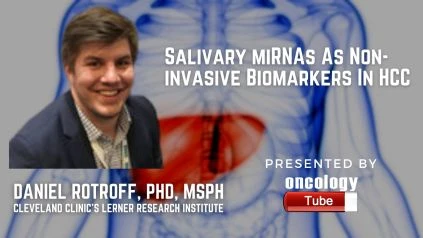Daniel Rotroff, Ph.D., MSPH, senior author of the study and researcher in the Department of Quantitative Health Sciences with Cleveland Clinic’s Lerner Research Institute. Dr. Rotroff conducted the research in collaboration with Dr. Frederico Aucejo, Director of the Liver Tumor Clinic at Cleveland Clinic; and Mrs. Arshiya Mariam, lead author of the study. In this video, he speaks about Salivary miRNAs as non-invasive biomarkers of hepatocellular carcinoma: a pilot study.
Â
Â
Overview:
Â
Origins:
Â
Current detection approaches for hepatocellular carcinoma (HCC), such as alpha fetoprotein (AFP) and ultrasound, are ineffective due to their low sensitivity. MicroRNAs (miRNAs) are short non-coding RNAs that regulate a variety of cellular activities and have an impact on the genesis and progression of cancer. MiRNAs, for example, maybe detected in saliva and have been found to have potential as non-invasive biomarkers for a variety of malignancies, including breast, oral, and lung cancers. We describe the first report of salivary miRNAs in HCC to our knowledge and compare our findings to those of patients with cirrhosis, a high-risk cohort for HCC.
Methodologies:
Small RNA sequencing was conducted on 20 individuals with HCC and 19 patients with cirrhosis. The samples from eleven patients with HCC who had chronic liver disease were mixed and sorted by the presence of chronic liver disease. Using a false discovery rate (FDR) technique, P values were adjusted for multiple comparisons, and miRNA with FDR P 0.05 was considered statistically significant. Differential expression of salivary miRNAs was compared to miRNAs in liver tissue of patients with HCC vs. cirrhosis, which had previously been described. To see if salivary miRNAs have predictive capability for detecting HCC, researchers used support vector machines and leave-one-out cross-validation.
Outcomes:
A total of 4,565 precursor and mature miRNAs were found in saliva, with 365 showing significant differences between HCC and cirrhosis patients (FDR P 0.05). 283 of these miRNAs were shown to be significantly downregulated in HCC patients. A combination of ten miRNAs and variables found by machine learning correctly categorized patients with HCC (AUC = 0.87). Furthermore, we discovered three miRNAs that were differentially expressed in HCC saliva samples and a recent research of miRNAs in HCC tissue versus cirrhotic liver tissue.
Observations:
For the first time, this study shows that HCC-related miRNAs may be detected in saliva, that salivary miRNA signatures have the potential to be highly sensitive and specific non-invasive biomarkers of HCC, and that bigger cohort investigations are needed.

